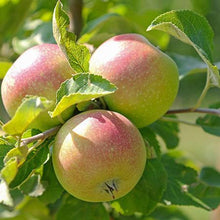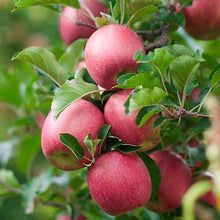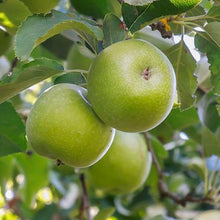
Two Delicious Apple Varieties On One Tree
With the Apple Surprise Tree you will never get bored of the same apple flavor over and over again because this tree produces two different types apples. You’ll be delightfully surprised because the apples range in taste from juicy and sweet to tart, giving you a variety of flavors from August through October.
This apple tree is an abundant producer, so you’ll always have crisp, juicy apples on hand for a refreshing healthy snack. You’ll also have plenty of apples for baking pies or juicing.
Instead of planting four different types of apple trees you can save space by only planting one Apple Surprise 2 in 1 tree. You’ll have tons of yard space to relax in, as well as an endless supply of fruit.
Enjoy tons of fragrant blossoms every spring when they cover your apple tree and fill the landscape with eye-catching color. The flowers cross-pollinate each other to fertilize each different type of apple.
Each type of apple is carefully grafted on to a mature and healthy rootstock by hand, with measures to ensure that the grafts don’t fail. As a result, Apple Surprise 2 in 1 trees are pest and disease resistant.
Apple Surprise 2 in 1 trees are also incredibly low maintenance. They’re drought tolerant and heat resistant, so they don’t require constant care or babying. Simply plant your tree and prepare for tons of apples.
While we can’t guarantee the exact types of apples that you will receive on this tree, you will receive four of the varieties listed:
McIntosh Apples
Gala Apple
Gravenstein Apple
Yellow Transparent Apple
Yellow Delicious Apple
JonaGold Apple
Honeycrisp Apple
Wealthy Apple
Johnathan Apple
Summer Red Apple
Cortland Apple
Fuji Apple
Planting & Care
An unique tree that gives you several varieties of apples with just one tree, this multiple graft apple (Malus sp.) is a pleasure to watch bloom and fruit. Growing in USDA zones 5-8, they can tolerate cold down to -10 degrees and do not require a lot of chill hours, so they can also grow in the south and still produce fruit. This dwarf fruit tree does not take up a lot of space in your landscape while still providing you with multiple varieties of apples. Only reaching 10-15 feet tall and 10 feet wide, it’s a great way to have several varieties of apple without having to have an orchard to do so. The multi-grafted apple does not require a pollinator as the different grafts naturally cross pollinate with one another!
Location: Be sure that the location you plan to plant your tree will receive full sun which means at least six hours of direct sun each day. If the area receives more than half a day’s shade then the tree will not perform well. Drainage is essential so if you have an overabundance of clay, some soil amending may be required. The pH range of the soil (for the best results) is 6.0-6.5 and a soil test can determine this easily. Testing kits can be found at your local gardening center to test the acidity of your soil. If the soil is mostly sand then amending peat moss into the sand will help with moisture retention otherwise more frequent irrigation will be needed.
Planting Directions (in ground): Now that you have found your ideal planting location for the Multi- apple there are some basic steps for planting the tree. You can raise the acidity of the soil if necessary using lime or wood ash. To lower the pH you can amend sulfur, sphagnum peat or aluminum/iron sulfate into the soil.
1) Make your planting site hole twice the width of the root ball and just as deep.
2) Gently comb your hands over the root ball to free up the roots before planting. Take care not to be to rough with the roots.
3) Place your new Multi-apple tree in the hole and be sure it’s straight as you begin to back fill the hole. Tamp down the soil as you fill the hole to prevent air pockets from forming.
4) Water the planting site to settle the soil and then mulch around the base to prevent competing weeds and grasses from growing around the area.
*Tip: Make sure your mulch is not touching the base of the trunk as this can encourage rot and fungus from forming.
Planting Directions (potted tree): Most wouldn’t think you cannot grow an apple tree that isn’t a dwarf variety in a pot. With the Multi-apple you can definitely grow a happy, healthy apple tree in a pot! Growing this way will also help maintain the tree at a more manageable height.
1) You will want to start off with a fairly large pot for the apple tree to have enough space to stretch out its root system. A ten gallon or even a fifteen gallon pot will be a good size to start with. Plastic pots may not be a good selection as they can get hot in the sun and aren’t insulated against the cold.
2) Select a well draining, quality potting soil mix to fill the pot.
3) Some light trimming of the roots is encouraged before potting the tree to prevent it from becoming a root bound mess in the pot. Snip the roots so they are about ½ inch from the inside wall of the pot.
4) Be sure you add enough soil to the bottom of the pot so the graft union will be level with the rim of the pot. Fill the pot until there is about a 2 inch space from the rim to the top of the soil.
Watering (in ground): Your Multi-apple will benefit from a regular watering habit each week. You may need to water more often in times of extreme heat or drought. The soil surrounding your tree should be moist, but never saturated. Light green leaves can be a sign of over watering, while drooping leaves can be a sign of both over or under watering.
Watering (potted): Water slowly when you irrigate the tree to ensure even moisturizing of the soil. When the tree is in a dormant state, only provide enough water to keep the soil slightly moistened. As soon as you see newer growth coming out of the tree you can water whenever the top 2 inches of the soil feels dry.
Pruning (in ground): Once your tree has become established and is starting to bear fruit, it will need some periodic, moderate pruning. Only prune the tree during times of dormancy making sure to remove any vigorous, upright stems which are quite common in the upper portion of the tree. Weak, damaged or dead branches should also be removed. Low hanging, droopy branches should also be removed. As a branch declines with age it should be cutback to let younger branches take over and produce better.
Pruning (potted): Once you have your tree potted and comfortable, prune the branches back to about








